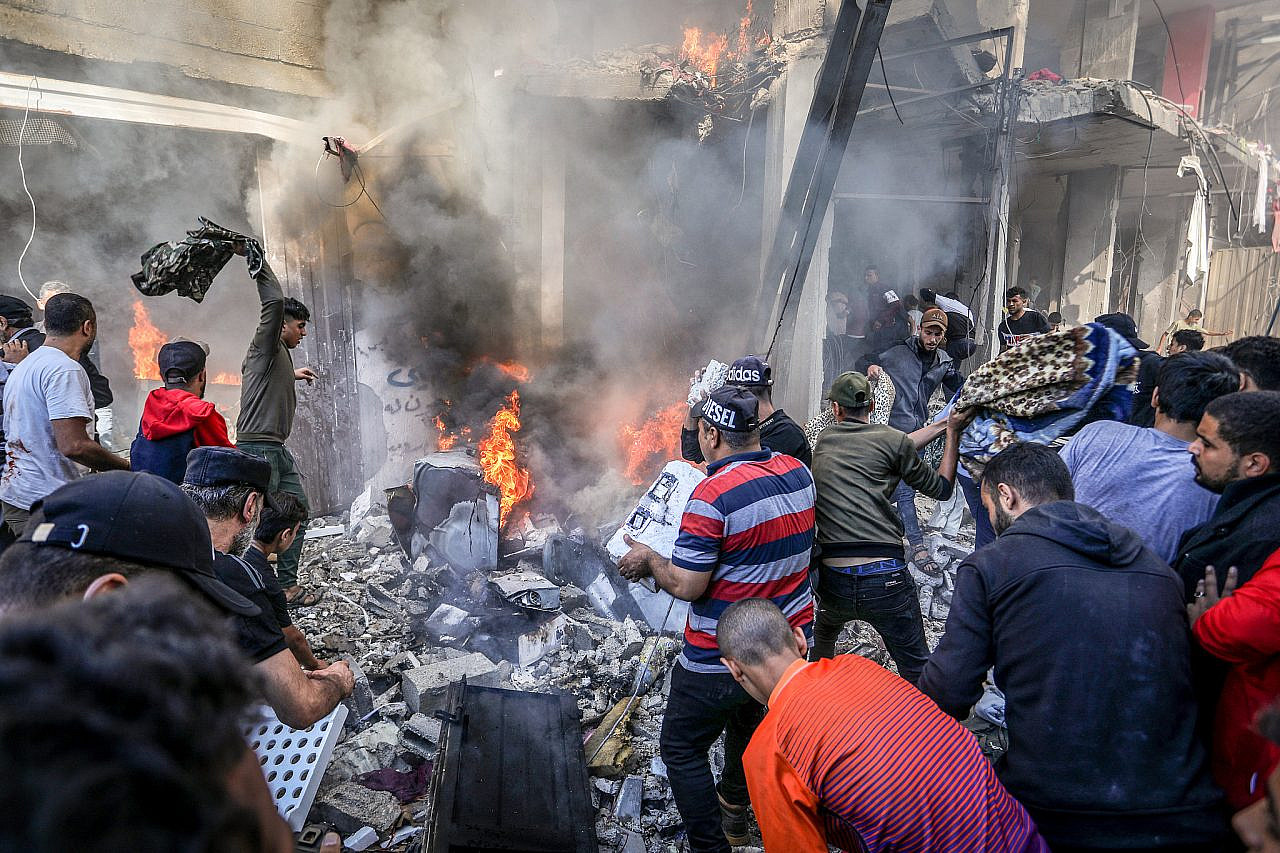 I live alone in my office. My wife and two young children moved in with her father after our apartment was shattered. The neighborhood mosque, where I have prayed since I was a child, had its roof blown off. All the government buildings on my beat have been obliterated.
I live alone in my office. My wife and two young children moved in with her father after our apartment was shattered. The neighborhood mosque, where I have prayed since I was a child, had its roof blown off. All the government buildings on my beat have been obliterated.
After days of Israeli shelling, the city and life I have known no longer exist.
Gaza City, with some 400,000 people, stopped supplying water when the fuel ran out for the power station driving the pumps. We listen to battery-run radios for news, even though the outside world watches what's happening to us on television. The Hadi grocery where we once shopped is closed. Food is scarce all over town.
Three days after Israel began its airstrikes against Hamas militants on Dec. 27, my apartment building was shaken by bombs aimed at a nearby Hamas-run government compound.
My brother took a picture of the room where my boys, 2-year-old Hikmet and 6-month-old Ahmed, once slept. Their toys were broken, shrapnel had punched through the closet and the bedroom wall had collapsed. I don't know if we will ever go back.
There are other pictures that haunt me. The Israeli army issued a video of the bombing of the Hamas-run government compound, which it posted on YouTube. In it, I also can see my home being destroyed, and I watch it obsessively.
Some of my colleagues lost their houses to the shelling as well, and are sleeping on mattresses spread across the floors of an apartment upstairs from The Associated Press bureau.
On Tuesday, I stood outside my apartment building but didn't dare enter. I was worried the remains of the nearby compound might again be shelled.
Othman, the owner of the Addar restaurant where my wife and I bought takeaway when we were both working, put up aluminum sheeting over the broken windows to stop looters. On the pavement, phone and power lines were tangled together like twine.
Driving to central Gaza City, I took the road where Gaza's two main universities are. It was covered with shards of glass, telephone cables, electricity wires and flattened cars. This road was once crowded with students, taxis and street vendors.
The Mazaj coffee shop on Omar Mukhtar street, Gaza's main thoroughfare, was shuttered. It was popular with wealthy university students and foreigners working for nonprofit agencies because it served really good Guatemalan coffee — rumored to have been smuggled in through the same tunnels under the Egyptian border the militants used to bring in weapons.
Al Dera, a beautiful hotel on the Mediterranean shore, was a place where young men and women smoked water pipes and flirted, and where families went for dinner on Thursdays.
Those days are gone now.
On Tuesday, the only shop I found open was the Shifa pharmacy run by my friend Eyad Sayegh. He's an Orthodox Christian, and I stopped to wish him a Merry Christmas — Eastern churches celebrate Christmas on Wednesday.
Eyad told me he forgot it was Christmas.
All the landmark buildings I covered as a reporter have vanished.
The colonial-era Seraya was the main security compound for the succession of Gaza's rulers — the British, Egyptians, Israelis, the Palestinian Authority and then the rival Palestinians of Hamas.
We used to fear the Seraya, where the central jail was. Now it's rubble.
The Al Shuhada mosque on the eastern corner of the compound, where I prayed every day, was one of the few in Gaza with good air conditioning. A local philanthropist who liked Moroccan architecture redecorated the interior with intricate wooden arabesques and Quranic verses etched on the roof. The roof caved in when the Israelis bombed the jail next door.
Of the presidential office overlooking the sea, only a few walls remain. For many Gazans it was a symbol of our statehood, even though President Mahmoud Abbas, who also heads the Fatah movement, hasn't been there since Hamas seized control of the territory in June 2007.
Someone planted a Palestinian flag on the building's remains. The huge gate at the western entrance still stands, giving an illusion of something big behind it.
And across the city, the Parliament house is half destroyed. It used to tower above the Unknown Soldier park and the shops that lined downtown Omar Mukhtar Street.
On Jala Street, one of Gaza's main roads, I saw about 30 boys around a leaky irrigation tap on a traffic island. They were clutching empty soft drink bottles and jerry cans, trying to fill them with water.
Samir, who is 9, told me his family has no water at home and he wanted to bring enough for a bath because he and his brother smell.
That's a problem for most people in Gaza right now.
In my father-in-law's building, residents throw out bags of spoiled food. With no power, refrigerators don't run and fresh food quickly rots.
There were few cars on the roads, and most of those were media cars, ambulances and vehicles packed with civilians. Some looked like they were fleeing, with mattresses tied to the roofs, but who knows where they can go.
Israeli helicopters flew overhead. I heard blasts in the distance. The roads were ripped apart by explosives.
I drove into downtown Gaza, trying to prove to myself I can still do something I have done so often before — drive through my city.
I reached the Catholic Latin Patriarchate School I attended, where my late father — also an AP correspondent — used to bring me every day. The building was undamaged.
I stood in front of it, wondering if I will ever be able to walk my children to this school.





 The United States will mark the 84th anniversary of the Japanese attack on the U.S. naval...
The United States will mark the 84th anniversary of the Japanese attack on the U.S. naval... In 2021, a book titled “The Human-Machine Team: How to Create Synergy Between Human and Artificial...
In 2021, a book titled “The Human-Machine Team: How to Create Synergy Between Human and Artificial...:focal(1285x1016:1286x1017)/https://tf-cmsv2-smithsonianmag-media.s3.amazonaws.com/filer_public/d1/4e/d14ed238-3b62-4506-9f53-fc2178dade60/nov2025_d17_prologue.jpg) In the fall of 1945, a bit more than six years after Nazi Germany invaded Poland...
In the fall of 1945, a bit more than six years after Nazi Germany invaded Poland... The last plane carrying U.S. forces left Afghanistan on Monday, meeting an Aug. 31 deadline to withdraw...
The last plane carrying U.S. forces left Afghanistan on Monday, meeting an Aug. 31 deadline to withdraw...






























